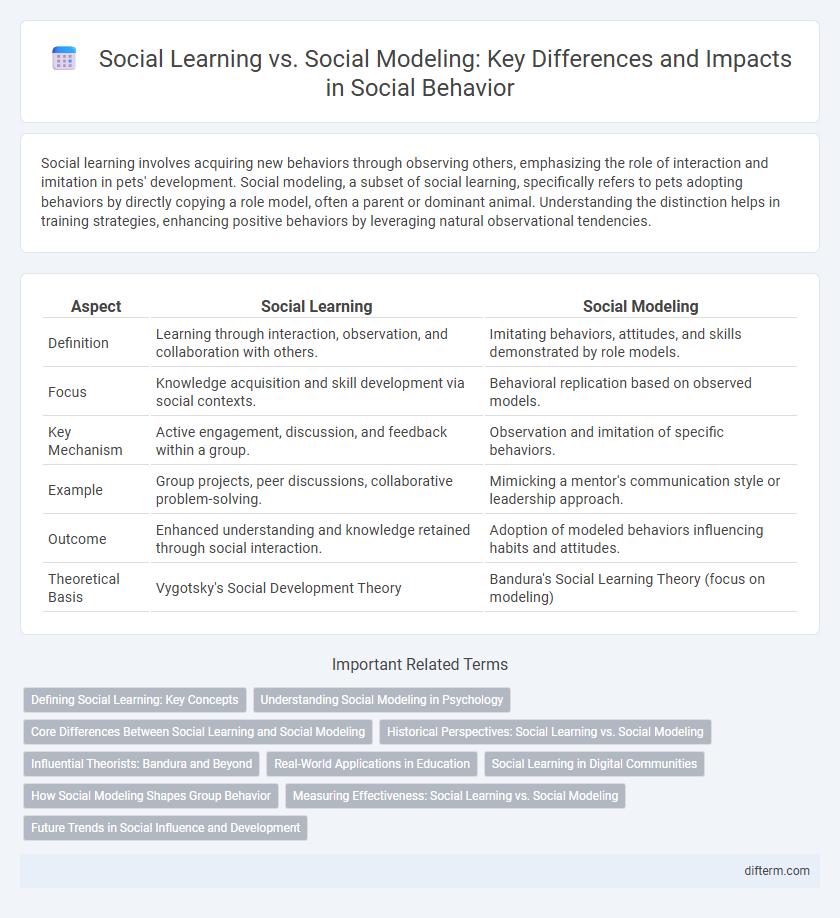Social learning involves acquiring new behaviors through observing others, emphasizing the role of interaction and imitation in pets' development. Social modeling, a subset of social learning, specifically refers to pets adopting behaviors by directly copying a role model, often a parent or dominant animal. Understanding the distinction helps in training strategies, enhancing positive behaviors by leveraging natural observational tendencies.
Table of Comparison
| Aspect | Social Learning | Social Modeling |
|---|---|---|
| Definition | Learning through interaction, observation, and collaboration with others. | Imitating behaviors, attitudes, and skills demonstrated by role models. |
| Focus | Knowledge acquisition and skill development via social contexts. | Behavioral replication based on observed models. |
| Key Mechanism | Active engagement, discussion, and feedback within a group. | Observation and imitation of specific behaviors. |
| Example | Group projects, peer discussions, collaborative problem-solving. | Mimicking a mentor's communication style or leadership approach. |
| Outcome | Enhanced understanding and knowledge retained through social interaction. | Adoption of modeled behaviors influencing habits and attitudes. |
| Theoretical Basis | Vygotsky's Social Development Theory | Bandura's Social Learning Theory (focus on modeling) |
Defining Social Learning: Key Concepts
Social learning involves acquiring knowledge, skills, and behaviors through direct interaction, observation, and participation within a social context, emphasizing collaborative engagement and shared experiences. Key concepts include imitation, reinforcement, and the role of social environments in shaping behavior, highlighting the influence of peers and group dynamics. Social modeling specifically refers to the process of learning by observing and replicating others' actions, serving as a mechanism within the broader social learning framework.
Understanding Social Modeling in Psychology
Social modeling in psychology refers to the process by which individuals learn behaviors, attitudes, and emotional responses by observing and imitating others, emphasizing the role of role models in shaping social development. Unlike social learning, which incorporates a broader range of mechanisms including reinforcement and cognitive processes, social modeling specifically highlights observational learning and the interactive influence of cognitive and environmental factors. Core concepts such as Albert Bandura's Social Cognitive Theory demonstrate how attention, retention, reproduction, and motivation are critical components in the effective transmission of social behaviors through modeling.
Core Differences Between Social Learning and Social Modeling
Social learning emphasizes acquiring knowledge through observation, imitation, and reinforcement within social contexts, focusing on the process of learning from interaction. Social modeling specifically involves demonstrating behaviors or skills as examples for others to replicate, highlighting the role of the model as a direct behavioral guide. The core difference lies in social learning encompassing broader cognitive processes and reinforcement mechanisms, whereas social modeling centers primarily on the demonstration aspect for behavior acquisition.
Historical Perspectives: Social Learning vs. Social Modeling
Social learning, rooted in Bandura's Social Cognitive Theory, emphasizes observational learning through imitation and reinforcement, highlighting how individuals acquire behaviors by watching others in social contexts. Social modeling, emerging from earlier psychological studies, specifically focuses on demonstrating behaviors for others to replicate, often used in educational or therapeutic settings to shape desired actions. Historically, social learning encompasses a broader cognitive process including attention, retention, and motivation, whereas social modeling concentrates on direct behavioral replication within social environments.
Influential Theorists: Bandura and Beyond
Albert Bandura's social learning theory emphasizes observational learning through imitation and modeling, highlighting the role of attention, retention, reproduction, and motivation in behavior acquisition. Beyond Bandura, theorists like Lev Vygotsky stress the sociocultural context and collaborative interactions essential for cognitive development, while Jerome Bruner focuses on discovery learning within social environments. These foundational perspectives collectively inform modern understandings of how individuals internalize and replicate behaviors within social frameworks.
Real-World Applications in Education
Social learning leverages collaborative environments where students learn through interaction, enhancing engagement and retention in real-world classrooms. Social modeling involves educators demonstrating behaviors or problem-solving strategies, enabling learners to imitate and internalize skills effectively. Both approaches improve educational outcomes by fostering active participation and practical understanding in diverse learning settings.
Social Learning in Digital Communities
Social learning in digital communities emphasizes the acquisition of knowledge through direct interaction, observation, and collaboration among users within online platforms. These virtual environments facilitate real-time feedback, peer support, and collective problem-solving that enhance cognitive engagement and skill development. Digital social learning harnesses user-generated content and social networks to create dynamic, context-rich educational experiences that outperform passive consumption methods.
How Social Modeling Shapes Group Behavior
Social modeling profoundly influences group behavior by demonstrating observable actions and their consequences, which group members imitate to align with shared norms. This process creates a dynamic environment where behaviors are continuously reinforced or modified based on social feedback and group expectations. As a result, social modeling fosters cohesion and guides the evolution of group culture through collective behavioral adaptation.
Measuring Effectiveness: Social Learning vs. Social Modeling
Measuring effectiveness in social learning involves assessing engagement metrics, knowledge retention, and collaborative problem-solving outcomes within group settings. Social modeling effectiveness is evaluated by observing behavioral changes, skill acquisition, and the replication of demonstrated actions through peer or mentor influence. Comparative analysis hinges on how both methods impact learner motivation, performance improvements, and long-term adaptation in social environments.
Future Trends in Social Influence and Development
Future trends in social influence and development increasingly emphasize the integration of social learning and social modeling through digital platforms, facilitating real-time collaboration and feedback. Advanced AI algorithms enable personalized social modeling experiences, enhancing skill acquisition and behavioral adaptation by mimicking influential peers. Emerging technologies such as virtual reality foster immersive environments where social influence accelerates cognitive and emotional development in diverse groups.
social learning vs social modeling Infographic

 difterm.com
difterm.com